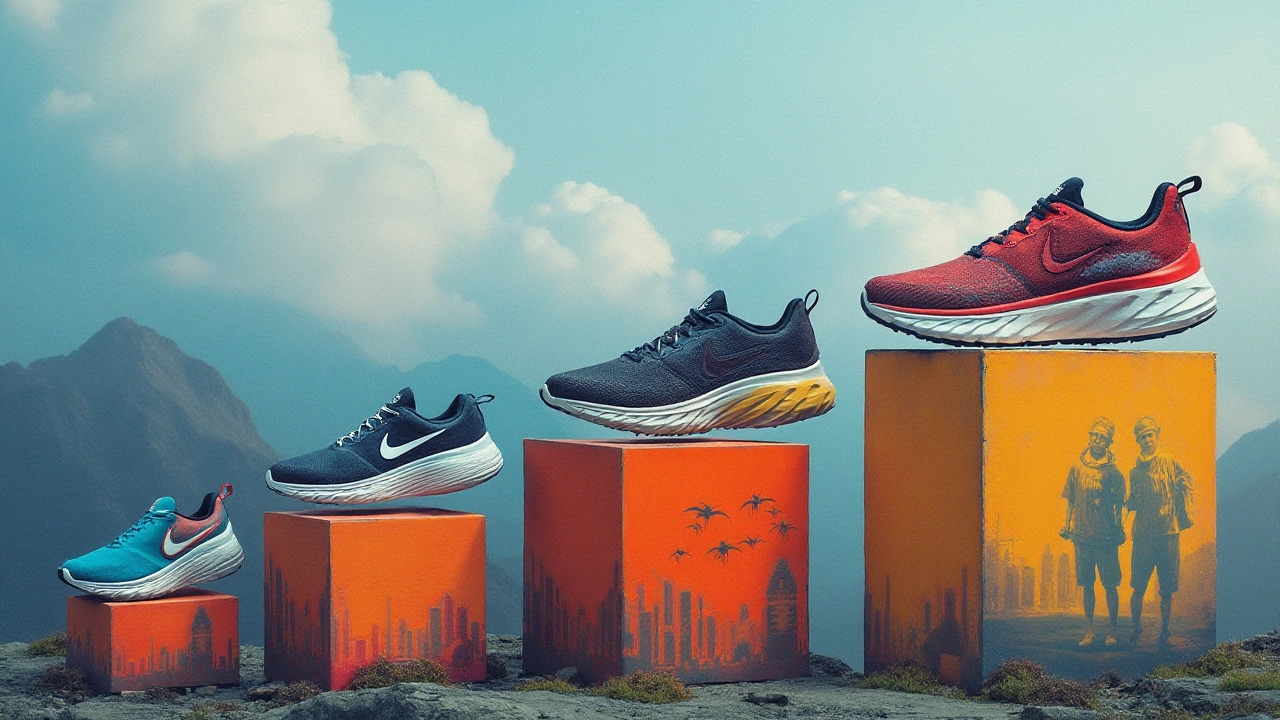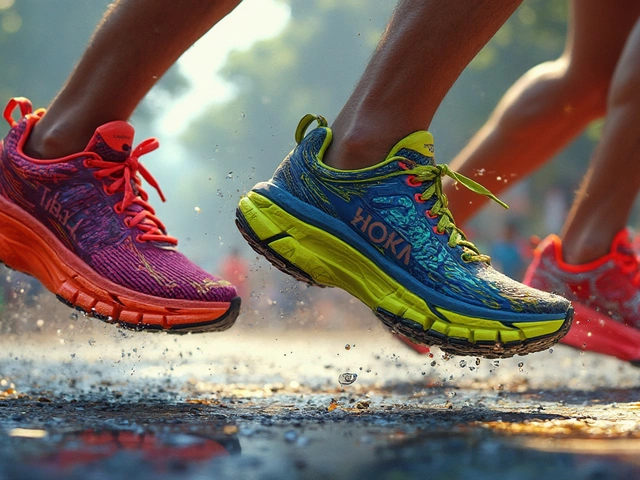HOKA, a vibrant name in the world of running shoes, often raises eyebrows when people ponder its ownership. In the realm of sportswear giants, associations with brands like Nike are not uncommon given their extensive reach. Yet, HOKA maintains its distinctively cushioned platform under a different flag.
Our journey begins by tracing HOKA's roots, a story not only of design innovation but also of strategic alliances and market placement. Delve into the intricacies of how HOKA carved its niche, exploring the fascinating dynamics with its actual owner, Deckers Outdoor Corporation, a fact that might surprise the casual observer.
Nike, due to its size and ubiquity, often becomes an imagined umbrella for many young brands, but HOKA's soul thrives elsewhere. We bring clarity to these associations, shedding light on how corporate ownership bridges with consumer perceptions. Such insights not only enrich our understanding of these brands but also illuminate how these connections shape the shoes we lace up for our runs.
- The Origins of HOKA
- HOKA's Unique Positioning
- Understanding Deckers Outdoor Corporation
- The Nike Association: Fact or Fiction?
- Impact of Brand Ownership on Consumers
The Origins of HOKA
HOKA's inception is rooted in the rugged terrains and breathtaking landscapes of France. It all began in 2009 when two seasoned trail running enthusiasts, Nicolas Mermoud and Jean-Luc Diard, envisioned a new kind of running shoe. Their goal was simple yet ambitious: to create a shoe that allowed athletes to run downhill faster and more comfortably. This vision steered them towards the creation of HOKA, a brand that quickly disrupted the industry with its maximalist cushioning. This revolutionary concept was a stark departure from the minimalist trends prevalent at the time.
The name 'HOKA' is derived from a Maori phrase that means "to fly over the earth," aptly capturing the founders' aim. Unlike any other running shoes available, these had oversized midsoles that were both lightweight and supremely cushioned. This design choice made them ideal not only for trails but also for a broad spectrum of running surfaces. Their distinctive look and feel attracted attention and soon captured the hearts of runners globally. What set HOKA apart was its promise of comfort and reduced muscle fatigue, which was a game-changer at the dawn of the 2010s.
In an industry filled with strong competitors, HOKA's founders leveraged every opportunity to showcase their creation. Blending innovation with tried-and-true performance enhanced their reputation. By addressing specific needs of the running community—such as impact comfort and stability—they built loyalty among elite athletes and casual runners alike. "Our design was no accident; it was a necessity born from our love of running," Nicolas once remarked, capturing HOKA's purpose in its truest form.
Their innovative approach soon led to partnerships that expanded HOKA's reach and appeal. The brand's early success captured the attention of Deckers Outdoor Corporation, known for its diverse range of outdoor and performance footwear brands. By 2013, HOKA had become part of Deckers' portfolio, benefiting from their extensive distribution networks and marketing expertise. This acquisition catalyzed HOKA's journey from a niche European novelty to a worldwide sensation, ensuring that more athletes could experience its unique ride.
As HOKA continued to evolve, its design innovations remained at the forefront of its mission. From lightweight yet robust fabrics to cutting-edge sole constructions, the brand consistently pushed the boundaries. Each model, launched year after year, embodied a commitment to fostering running experiences that were as enjoyable as they were efficient. This commitment to innovation and excellence is clearly visible in every iteration, which keeps HOKA at the top of its game.
HOKA's Unique Positioning
When it comes to the running shoe market, HOKA has crafted an identity that stands out with bold innovations and an approach that caters to avid runners and casual enthusiasts alike. Known for its distinctively maximal cushioned soles, HOKA's design philosophy contrasts with the minimalist trends seen in other brands. These shoes, with their oversized midsoles, offer an improved running experience by enhancing shock absorption, providing excellent comfort over long distances which is a compelling choice for both elite athletes and weekend warriors.
The brand has cleverly positioned itself at a crossroads where style meets functionality. Their eye-catching designs marry vibrant colors with practicality, a factor that appeals to a diverse consumer base. HOKA's unique positioning didn't happen overnight; it stems from a history of carefully orchestrated marketing strategies and an emphasis on technology-driven performance enhancement. Unlike some competitors who predominantly rely on flashy marketing, HOKA prioritizes the feedback loop with athletes, nurturing authentic relationships with the running community to refine its products consistently.
What's fascinating is how HOKA engages with its audience beyond just selling shoes. Their community-focused campaigns and partnerships underscore a philosophy that running can and should be enjoyed by anyone, anywhere. This is reflected in their product line which caters not only to road runners but also trail enthusiasts and those seeking recovery footwear. As Richard Feloni noted in a Business Insider article, HOKA's growth surged as it "capitalized on a market hungry for not just new aesthetic choices but palpable performance benefits."
To illustrate HOKA's competitive edge, consider their aggressive growth strategy which includes an expansion into store shelves across 60 countries, demonstrating a global appeal that extends way beyond their Californian roots. This far-reaching impact is even more impressive when you consider the plethora of models that have each carved niches in various categories of the running world. A tribute to their inventive spirit is reflected in the diverse roster of sponsored athletes who swear by their shoes, bringing credibility and visibility to the brand in competitive arenas.
HOKA's unique positioning is a tapestry woven from thoughtful product development, strategic brand presence, and a genuine connection with its core users. The brand doesn't merely follow trends but rather sets them by continually challenging conventional boundaries and pushing toward new horizons in footwear innovation. For those seeking a shoe that marries technology with comfort, HOKA remains an undeniable choice in an increasingly crowded running landscape.

Understanding Deckers Outdoor Corporation
Deckers Outdoor Corporation is an entity often recognized for its robust portfolio in the sphere of footwear, a journey that impresses with its strategic foresight and branding acumen. Established in 1973, Deckers has slowly become a titan in its field, housing not only HOKA but also beloved names like UGG and Teva under its expansive wing. The corporation exemplifies a blend of market diversity and niche craftsmanship. Each brand within its collection maintains a distinct identity, tailored towards different segments and lifestyles, thus reflecting Deckers' business model of 'house of brands,' where individual brand autonomy is highly valued.
Run by David Powers as CEO, the corporation thrives on principles of sustainability and innovation, paired with an ever-evolving digital strategy. Deckers seizes opportunities amid changing retail landscapes, using e-commerce and direct-to-consumer models that not only fortify its presence worldwide but also align with the current digital shift in consumer behavior. This agile approach is indicative of why Deckers remains competitive despite various market challenges.
The company is headquartered in Goleta, California, a location symbolic of its laid-back yet high-performance ethos. A glance at the financial health of Deckers reveals a solid footing, with revenue streams reflecting steady growth. In fact, as per their recent reports, Deckers' revenues crossed the $2 billion mark, painting a picture of a thriving business. This success is attributed to its tactical expansions and rejuvenating existing brands, ensuring they resonate with both loyal customers and new markets.
In the words of Andrea O'Donnell, President of Fashion Lifestyle, "Our strength comes from understanding the consumers and meeting their expectations without compromising the values our brands stand for."
"Brand loyalty is something we cultivate, not through mere transactions but through understanding the soul of our customers," said O'Donnell in a recent industry panel.Such insights from leadership illuminate how Deckers passionately combines customer insights with brand ingenuity to maintain its stronghold in the fiercely competitive footwear industry.
The Nike Association: Fact or Fiction?
When discussing the ownership of prominent sports shoe brands, it's not uncommon for people to mistakenly believe that innovative companies like HOKA fall under the expansive portfolio of industry giants such as Nike. This assumption, while understandable given the omnipresence of Nike in the athletic market, is actually far from reality. HOKA, known for its distinctively bold cushioning and design philosophy, operates independently of Nike's ownership. Instead, HOKA exists under the wing of Deckers Outdoor Corporation, a respected name in the footwear and apparel industry that also boasts other notable brands such as UGG and Teva.
The strong association with Nike can perhaps be attributed to the similar target demographic catered to by both Nike and HOKA: running enthusiasts who value both performance and style in their footwear. While Nike has capitalized on its broad appeal across various sports disciplines, HOKA's rise stems from its ability to address specific needs in the long-distance running sector, a niche that's both growing and highly competitive. This focus on specialized needs can make it easy for the average consumer to lump all successful brands together, especially those that share retail space and market attention.
In dissecting the ownership myth, it's essential to consider the role of marketing and consumer perception. The power of branding often leads consumers to draw imaginary lines connecting names and logos, crafting associations that are more about perception than fact. Interestingly, companies like Nike have a history of acquiring or investing in promising brands, making it plausible for speculation regarding ownership. Yet, as HOKA continues to flourish under Deckers, it remains unacquired by Nike—illustrating that not all assumptions stand true against the backdrop of corporate reality.
"People often assume brand ownership based on visibility. In truth, strategic placements and partnerships shape these perceptions more than mere brand names," notes a market analyst from the Footwear Distributors and Retailers of America.
To highlight the real divide between these companies, it's beneficial to assess their operational strategies. While Nike drives large-scale innovation with frequent global campaigns, Deckers fosters HOKA's development by emphasizing technology and runner-centric solutions. Furthermore, the strategies employed by each brand differ significantly; Nike's robust digital presence often gets juxtaposed with HOKA's community-driven marketing initiatives, which include unique race sponsorships and collaborative events targeted to its core audience.
Adding concrete data to the narrative, evidence shows that as of the latest reported quarter, Nike's revenue from running shoes accounted for a significant portion of its overall sales, yet HOKA's dedicated customer base has led to impressive year-over-year growth within Deckers, providing a rationale for brand independence. The absence of a corporate merger or acquisition with Nike is not just a legal or business fact, but an ongoing strategy that allows both brands to thrive in their respective spaces while contributing to the diverse landscape of athletic footwear.

Impact of Brand Ownership on Consumers
The intricate web of brand ownership plays a crucial yet often overlooked role in consumer behavior. When a brand like HOKA is affiliated with a well-known parent company, it can significantly affect how consumers perceive the quality, innovation, and ethical practices of the products they endorse. A strong association with an industry giant might bring a sense of reliability and heritage, which often translates into increased consumer trust. However, it can also stifle the perceived uniqueness and innovation that the brand might otherwise represent.
Many seasoned runners, for instance, may favor HOKA not just for the superior cushioning and support the shoes provide, but also because of its branding autonomy, believing that it allows the company to focus more on performance-oriented designs rather than being overshadowed by the overwhelming persona of a massive corporation like Nike. It’s the emotional connection and assurance of craftsmanship that drives loyalty. Contrary to this, newer entrants into the running scene might lean towards brands associated with larger corporations, assuring them of a wider range of choices, better availability, and after-sales service.
Consumer perception can also be influenced by how a parent company positions its subsidiary in the market. A strategic decision by Deckers Outdoor Corporation to highlight HOKA's innovative roots and focused mission can maintain its allure of exclusivity despite not being under Nike's umbrella. This often takes place through storytelling and brand communications, aiming to retain the narrative of a specialty brand. An intriguing aspect of brand ownership lies in how it shapes the competitive landscape, particularly when consumers consider the ecological and ethical practices of parent companies. Environmental and social governance, for example, can no longer be ignored, and consumers today are keenly aware of how a company’s overarching values align with their own, impacting purchasing decisions.





